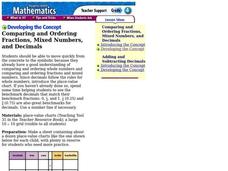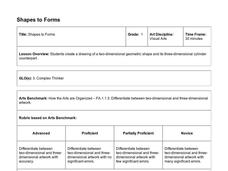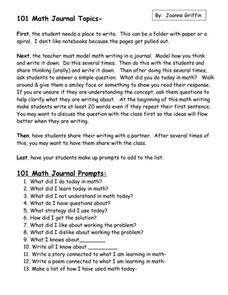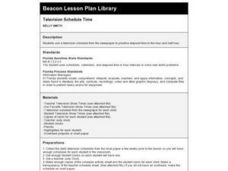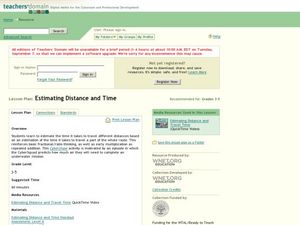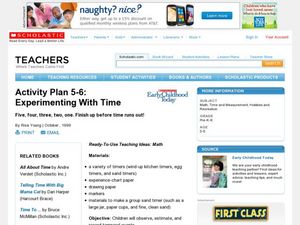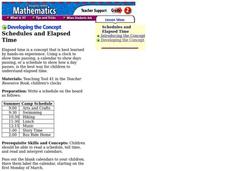Curated OER
Square Roots Using a Carpenter's Square
Students calculate the square root of a given number using carpenter's square measurements. In this math lesson, students relate this method on the Pythagorean theorem. They answer practice problems after the exploration activity,
Curated OER
Mentally Add and Subtract 10 or 100
Here are some number lines that need to be completed. There are two number sequences, one to test addition skills and the other for subtraction. Both sequences include counting by 10, but the subtracting question has scholars count...
Curated OER
More or Less Pigs in the Pen
Kindergarteners practice basic addition and subtraction. For this math lesson, students sing a song about pigs on a farm to help them understand the concept of adding and subtracting things together. Some excellent extension activities...
Curated OER
Comparing and Ordering Fractions, Mixed Numbers, and Decimals
Students practice comparing and ordering fractions, mixed numbers, and decimals. In this fractions, mixed numbers, and decimals lesson, students examine a decimal place value chart compared to a whole number place value chart. They...
Curated OER
Alexander, Who Used to be Rich Last Sunday
What a great way to incorporate Judith Viorst's story, Alexander, Who Used to Be Rish Last Sunday, with a math lesson on money. Second graders listen to the story being read while the teacher stops to record each time Alexander spends...
World Wildlife Fund
Take 6
Investigate the various properties of the number six with this elementary math lesson. From simple addition, subtraction, multiplication, and division problems to the creation of hexagonal tessellations, this lesson covers all aspects of...
Curated OER
Shapes to Forms
Here is a math lesson that is really a visual arts lesson in disguise! In it, pupils utilize their knowledge of geometric shapes and forms to create a detailed version of a cylinder. The instructions on how to go about the task are very...
Curated OER
See Turtles Nest! See Turtles Hatch!
Students graph data of sea turtles hatching rates from Watamu/Malindi Marine National Park and Reserve in Kenya. In this math lesson, students use real life science data to calculate mean and median values. Students use...
Curated OER
Lesson Plan: Defining, Describing and Calculating Rate
Students view Cyberchase video to introduce calculating speeds. For this rate and distance lesson, students make original tables showing rate, distance and speed. Students analyze distance - time graphs for understanding.
Curated OER
Uniform-Motion Problems: Just Playing with Cars
Students explore the concept of the formula for distance. In this formula for distance lesson, students time battery operated cars with constant velocity over 15 meters. Students use the distance = rate x time formula to determine the...
Curated OER
Rice Math
Sixth graders calculate the amount of rice there will be if the amount is doubled everyday. In this multiplying instructional activity, 6th graders are given an amount of rice that is grown each day. Students then calculate how much rice...
Curated OER
Measuring Elapsed Time
Fifth graders convert units within the same measurement system and be able to determine elapsed time. They are given a start time and an end time of a game. Students determine the amount of elapsed time from the data that is given.
Curated OER
It's Time to Make Time!
Students explore the evolution of time measurement, and explain the relationship of sunrise/sunset to length of daylight. They collect data and calculations to determine length of daylight during a given day.
Curated OER
Math Investigations Facilitation Plan
In this math lesson plan, learners choose a topic involving math that interests them to investigate or research. Students make a plan detailing how they will investigate their topic; such as, keeping track of plant heights over time,...
Curated OER
101 Math Journal Topics
In this math worksheet, students examine the topics available to complete a daily math journal. They repeat the procedure for future lessons.
Curated OER
Television Schedule Time
Young scholars consider the concept of elapsed time by examining television schedules. They list five television shows and highlight them in a newspaper, marking down the beginning and ending time of each show. They use clocks to figure...
Curated OER
Estimating Distance and Time
Pupils analyze a Cyberchase video to help them understand how to estimate the time it takes to travel distances. In this time lesson, students use ratiosand repeated addition to calculate how much air the characters in...
Curated OER
Math by M&M's
First graders review math skills with M&M's. In this math lesson, 1st graders practice addition and subtraction skills with M&M candies.
Curated OER
Figuring Elapsed Time
Students discover the concept of elapsed time. In this calculating time lesson, students utilize the Internet to complete record sheets based on the concept of elapsed time. Finally, the students answer questions on their own.
Curated OER
Experimenting With Time
Students experiment with time. In this time lesson, students discuss the importance of time and clocks. They use a timer to find how long it takes to complete activities.
Curated OER
Party Time
Young scholars explore the cost of a party. For this math lesson, students plan a party and determine the cost of hosting a party. Young scholars use information from grocery stores to determine the unit cost of items for the party.
Curated OER
Schedules and Elapsed Time
Students answer questions about elapsed time in the calendar. In this elapsed time lesson plan, students discuss a schedule that is given to them, and then answer questions about time passing on a March calendar page.
Curated OER
Transportation Math
Learners use mathematical operations to examine truck drivers and the math they use everyday. In this transportation math lesson, students read word problems that relate to transportation and the math needed to solve the word problems....
Curated OER
Telling Time to 5 Minutes
Students take part in various activities ranging from creating a human clock, to small group problem solving to reinforce the concept of telling time accurately to five minutes on an analog clock.





